The Amazon Basin is a mysterious place where many strange creatures have been known to live, even today, although were not talking about prehistoric monsters or man-eating plants.
Although the author lives in Brazil, he is from the southern part of the country, very far from the Amazon (more than 2,000 milesl), and he can suggest some interesting experiments and projects with small (and docile) creatures from the Amazon easily found even in the United States. In some pet shops (yes, pet shops!), it is possible to find some of these strange creatures that live in the Amazon and use them in bionics projects like the ones described here.
One of those curious creatures is the electric fish Black Ghost (or Itui Cavalo in Portuguese), known by many who keep small aquarium fish (see Figure 1).
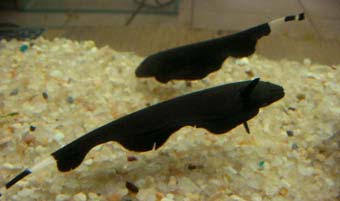
The Black Ghost (Genus Apteronotus, and families Electrophoridas, Gymnotoidae, Rhamphichthidae, Hypopomidae, and Sternopygidae) and some catfish have the ability to produce electric, lowfrequency fields around their bodies that are used to detect other beings and objects.
The same principle of operation is used by equipment that is used to detect mineral deposits and even large objects in the sea. The idea is that a “current field” is deformed by the presence of objects of different conductance, as shown by Figure 2.
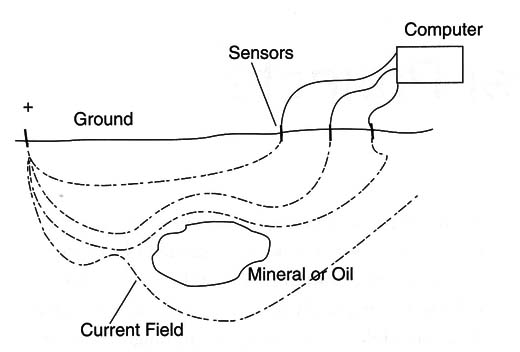
Electrodes can map the currents and determine the location of the objects that produce the deformation of the field.
The fish uses this principle to detect objects and other creatures in the dark water where he lives. The Itui is nearly blind and must depend on his electric sense to find food and escape from enemies.
Figure 3 shows how the Itui produces an electric current field in the water both to detect objects and communicate with other fish of the same species.
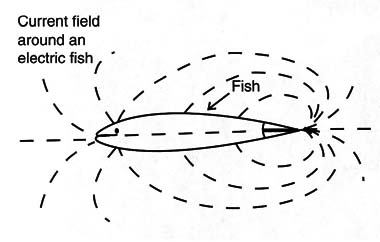
The most interesting points to consider are the characteristics of the fish’s electric field and the sensors developed by the fish’s nature. The fish produces a very stable, low-frequency field with frequencies that depend on the size of the specimen and the chemical conditions of the water around him or her.
For our experiments, we recommend the use of the Itui Cavalo or Black Ghost (Apteronotus Albifrons, the Gymnotoidae Family), which produces very stable, low-frequency fields in a range between 400 and 4,000 Hz.
Figure 4 shows a typical wave shape of the current field generated by the electric fish.
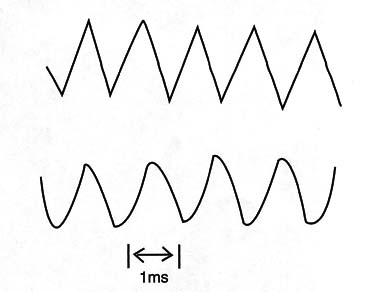
Placing metal electrodes near the fish, it is possible to pick up the signal produced by the fish and use it to make interesting bionic experiments, as we will describe in the this section. Of course, the reader can go ahead and create his or her own experiments with the electric signals produced by this strange creature.
Since the signal generated by the fish is very stable in frequency, the reader can consider it as a living “quartz crystal” or “tuning fork,” which can be used to drive computers, microprocessors, clocks, and even a musical instrument, as suggested in the next section.
Experiments in Bionics
The signals generated by the Black Ghost reach an amplitude ranging from 3 to 4 volts, which is enough to drive many external electronic circuits.
The simplest experiment, described here, is made by picking up the signals and using them to drive a small audio amplifier. When amplified, the lowfrequency signals can be heard as a pure audio tone in a very interesting experiment involving animal behavior. In a science fair or even in the lab, it is nice to see how impressed people are when the pure tuning-fork sound produced by the fish is heard. You can also perform other projects such as the following:
The stable signal can be used to drive a digital or mechanic clock.
A signaling system can be driven by the fish, indicating to his or her owner that the fish is alive. A light-emitting diode (LED) will blink, controlled by the signal produced by the electric fish.
It was shown that the frequency of the signal produced by the fish changes slightly when the pH or the CO2 concentration of the water changes. This means that, monitoring the frequency of a Black Ghost, you can develop a bionic sensor of pollution for water sources. The signal can be picked up and applied to a computer to monitor the water of a source using a living sensor.
The frequency of the signals also changes when the fish is disturbed by external influences. You can create an earthquake or tsunami detector based on the fish’s reaction -an interesting form of research to be made these days.
Dividing the signals by fractions of 8 (1/8, 2/8, 3/8, etc), you can build a musical instrument operating from the signals generated by the fish.
Knowing the frequency of your fish, you can build an oscillator to produce the same signal and make experiments to see how it can be disturbed.
Electronic Circuit for the Experiments
Our basic project consists of a simple, low-power audio amplifier used to pick up the signals generated by the fish. The signals are amplified and applied to a loudspeaker, or reproduced by a loudspeaker as shown in Figure 5.
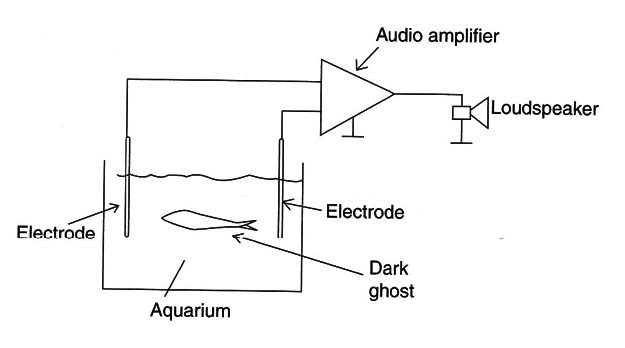
Although you can use any audio amplifier for this purpose, the experimenter can build his or her own circuit and make experiments with the signals, placing new blocks in the same solderless board.
The circuit is based on the integrated circuit (IC) LM386, which can be powered from four AA cells, producing a good audio signal to a small loudspeaker. The gain of the circuit is determined by the capacitor placed between terminals 1 and 8. In our case, because the signal picked up by the electrodes is weak, we recommend working with high gain. So, a 10 ,uF signal is used, resulting in a voltage gain of 200.
The electrodes are pieces of bare wire immersed in the aquarium with the fish. It is recommended that the wires be 20 to 30 cm long and that they are separated by 20 to 50 cm, as shown in Figure 6.
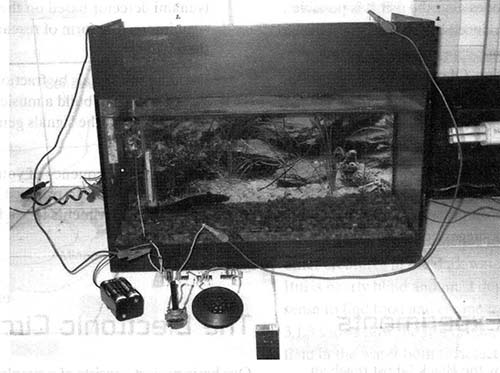
It is not recommended that you power this circuit from the AC power line, even using a good power supply. The 60 Hz hum can disturb the operation of the circuit, appearing in the loudspeaker.
How to Build
Figure 7 shows the schematic diagram of the audio amplifier used in the basic experiment.
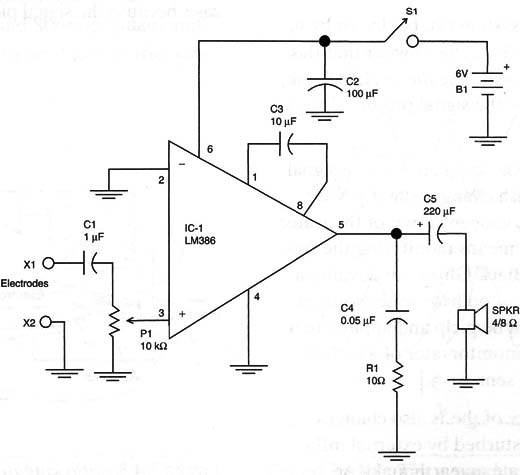
The components can be placed on a solderless board, as shown in Figure 8.
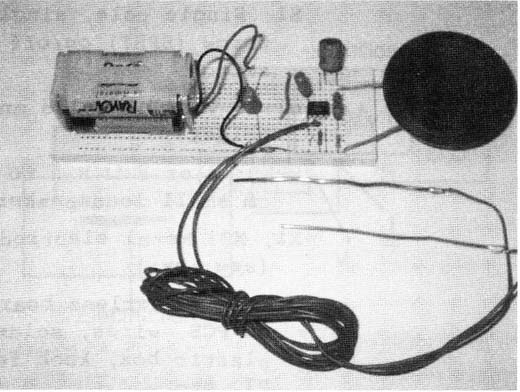
This mounting process is particularly recommended to beginners and for experiments made in a lab, because the materials used to etch a PCB are not necessary. Of course, if the reader has the resources to etch a PCB, he or she is free to choose this mounting version for his or her amplifier.
The PCB version is shown in Figure 9.

The positions of the polarized components, such as the IC and the electrolytic capacitors, should be observed. The loudspeaker can fit inside a small plastic or wooden box, and an appropriate holder should be used for the cells. In this mounting, as the circuit works with low-power audio signals, it is very important to keep all the connections and the components’ leads as short as possible to avoid instability or picking up undesirable hums.
Testing and Using
Turn the unit on by using S1 or by placing the cells in the holder and plugging in an audio source, such as a ceramic microphone. If you intend to use an electret microphone, a 10,000-ohm resistor should be added, as shown in Figure 10.
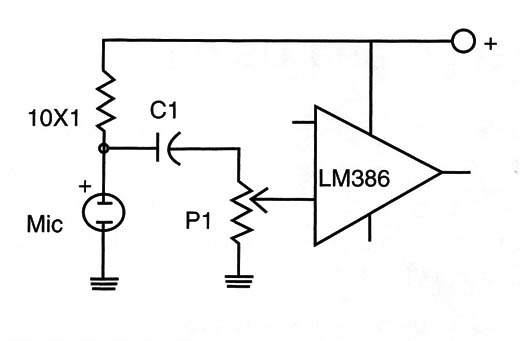
To pick up the signals generated by the Black Ghost, you must place the electrodes into the aquarium and connect them to the input of the audio amplifier using common wires (no shielded wires are needed if the distance to be covered is short). If your aquarium has a fluorescent light and/or a heater, it is recommended that you unplug them from the power line to not introduce noise to the circuit.
Since the water is almost conductive, the aquarium acts as a low-impedance signal source. This means that if you haven’t any other powerful interference source near the aquarium, such as electric devices, no hum will appear in the loudspeaker.
Opening the volume control, you will hear a pure tone, like an audio oscillator or tuning fork, which will change in volume when the fish moves to another place inside the aquarium. This tone is the signal produced by the fish.
Unplug the electrodes to be sure that the picked-up signals are really produced by the fish. If the noise (hum) is reproduced by the speaker, see if any appliance connected to the AC power line that is placed near the aquarium is the cause.
IC-l: LM386, audio amplifier, integrated circuit
C1: 100 µF x 12 V electrolytic capacitor
C2: 10 µF x 12 V electrolytic capacitor
C3: 220 µF x 12 V electrolytic capacitor
C4: 0.05 or 0.047 µF ceramic or polyester capacitor
P1: 10 k ohm log or lin potentiometer
R1: 10 k x 1/8 W resistor, brown, black, black
S1: Single pole, single throw (SPST) on/off switch
B1: 6 V, 4 AA cells and holder
SPKR: 4 or 8 ohm x 5 to 10 cm small loudspeaker
X1, X2: Metal electrodes (see text)
Other: Solderless board or PCB, wires, solder, plastic box, knob for P1, etc.



